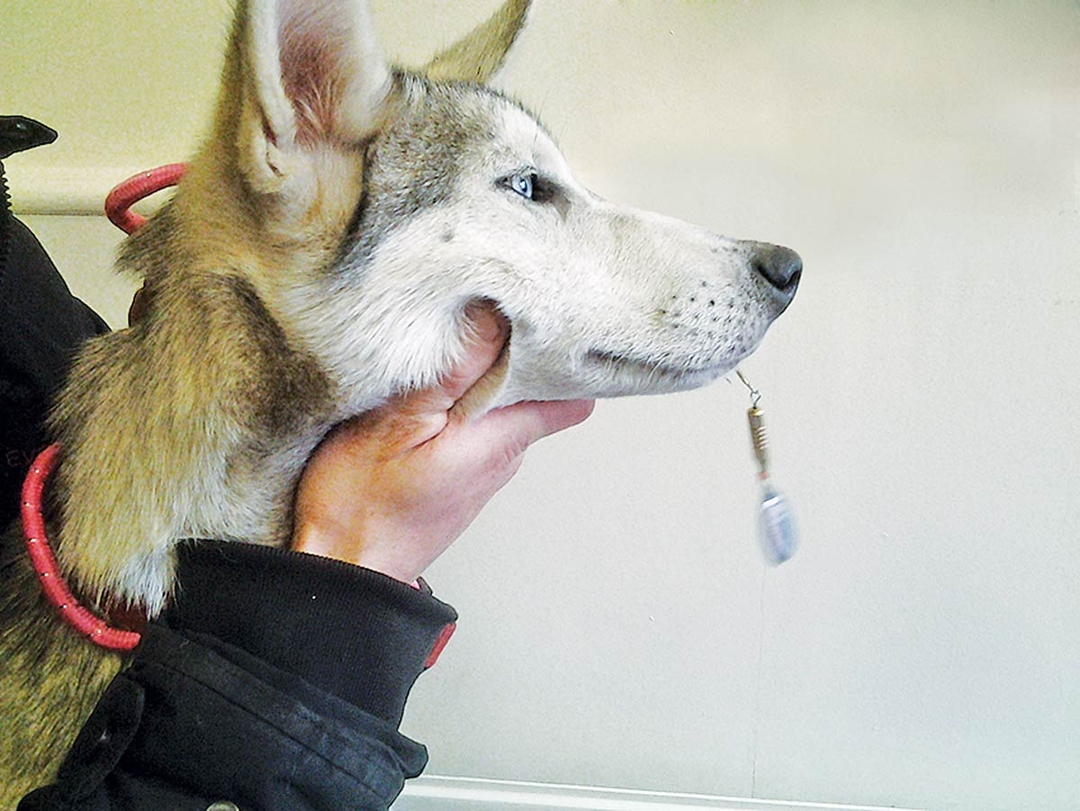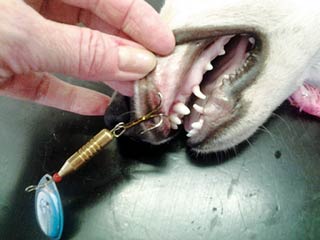30 May 2016
Suzhy Winfield recounts a case of a mouth injury caused by a fish hook in a young husky to highlight the dangers of leaving this item of fishing equipment lying around.

How the dog arrived at the author’s practice.
With a husband who is a keen fisherman, I am well aware of fishing seasons – open, closed, lake, river, coarse and so on. Whatever your personal views on fishing, the one resounding feeling among most is hooks used should never be left lying around on the ground.

Every year we see more injuries to dogs as a result of fishing hooks, fishing lines and accessories left on bank sides by anglers. This year, however, we saw our first one very early.
A husky was rushed in one morning by its owners, having just witnessed it injuring itself on the three-pronged hook. The dog was seven months old.
The owners were, understandably, distraught. We all know in the veterinary profession a little blood goes a long way, so you can imagine the amount from this dog’s upper lip with two of the prongs being barbed, having gone straight through, and the panic that ensued by both the dog and its owners.
The squealing and crying the husky made as it sustained the punctures, the owners said, would haunt them for a long time.
On examination, the dog seemed very distraught and in a great deal of discomfort. Its owners were having to restrain the head to stop the dog from shaking it, in a vain attempt at removing the hook. The dog was so traumatised, it was not able to control its bowel movements, which led to more stress for him.
It was obvious the dog was going to have to be sedated to remove the hooks and with this shock came the financial implications as well for the owners. We have all been there when funds are an issue, but the patient could simply not be left without the treatment.
The dog was sedated and administered an injectable pain relief and antibiotic. Then, with wire cutters, the arm of the two hooks was snipped and the barbed point was pushed from the inside through the outer skin of the upper lip – the only way to remove these as the barb has to go forward, not backwards.

The puncture wounds were then cleaned and the dog woken up and monitored. It went home with a course of antibiotics and pain relief. To sum up, trauma to the dog and a very unexpected veterinary bill for the owners. We will never know what attracted the dog to the hook – perhaps the shiny lure, or bait left on it.
This is unnecessary trauma to any animal, writes vet Viorel Teodoru. Very rarely do we see a fish hook injury that can be dealt with without the need for sedation or a general anaesthetic and these obviously carry a risk. If the patient is older then the risk increases or, if it is on medication, that can affect bleeding times – or heart medication.
This dog was lucky in the sense the two hook arms were accessible and could be snipped. Sadly, though, this is not always the case. We sometimes see dogs that have ingested the hook with or without line, which is potentially more serious.
I urge all vets to carry a selection of fish hook disgorgers. My VN, Suzhy, introduced me to these, which are fantastic for removing accessible hooks.